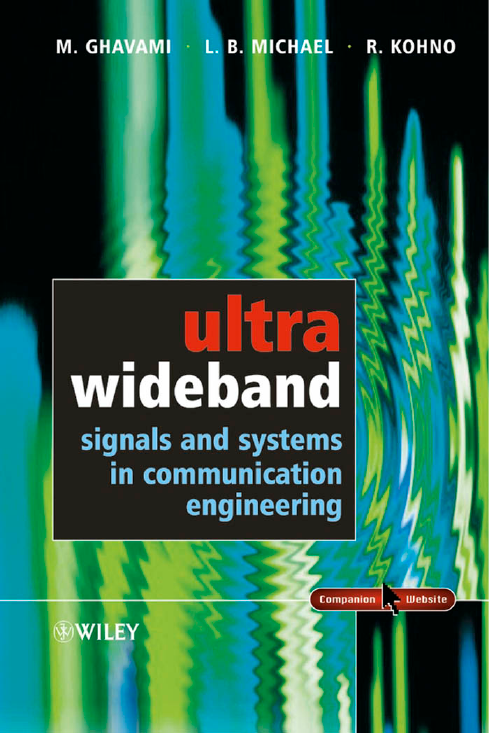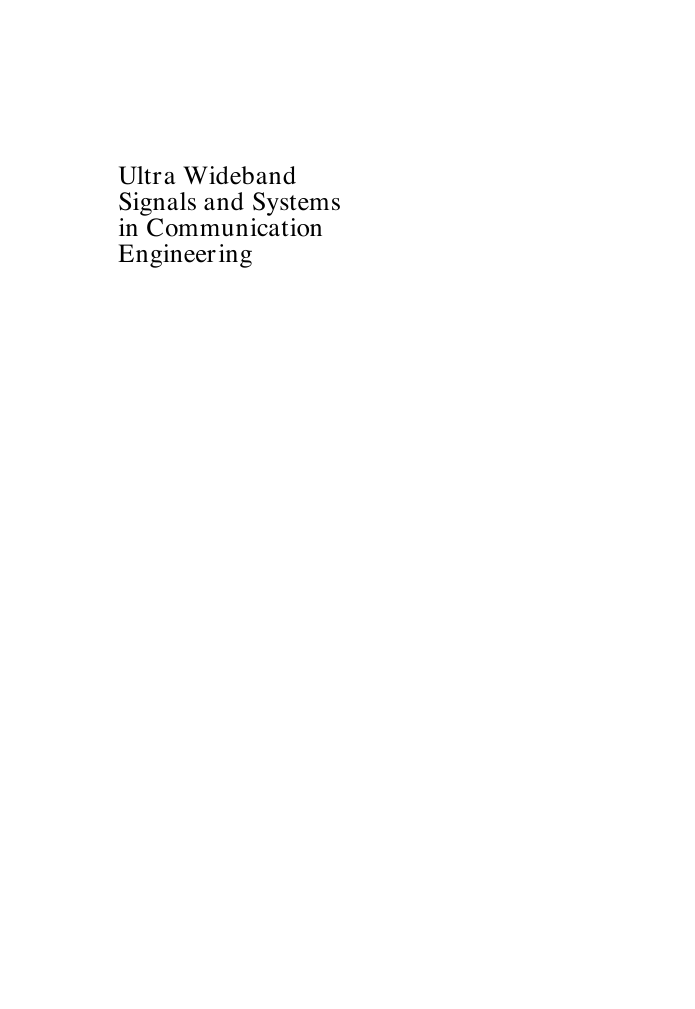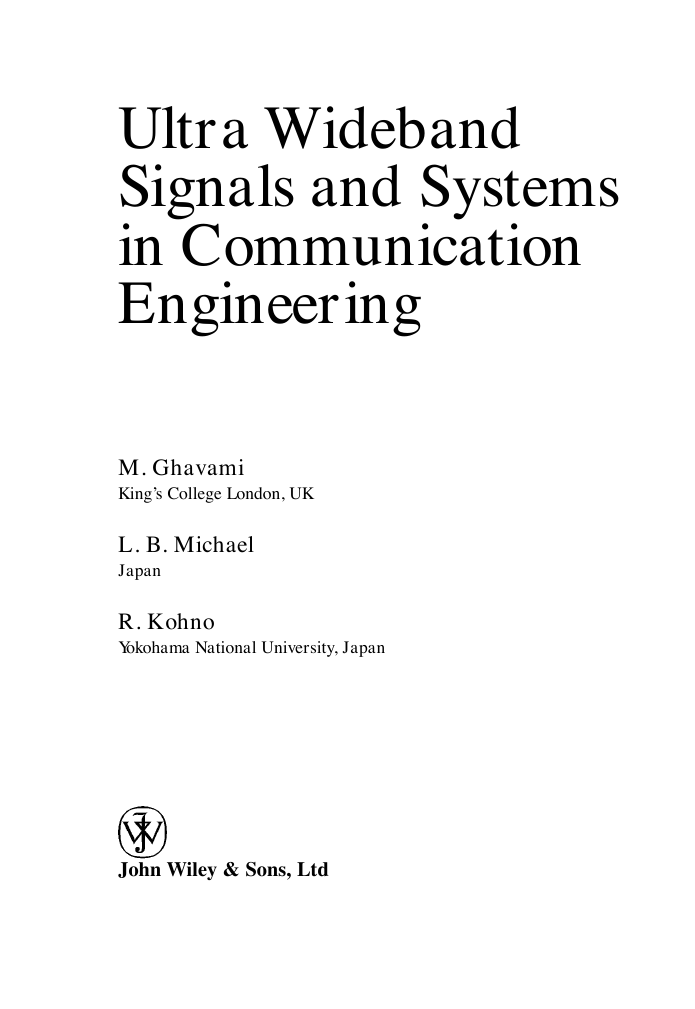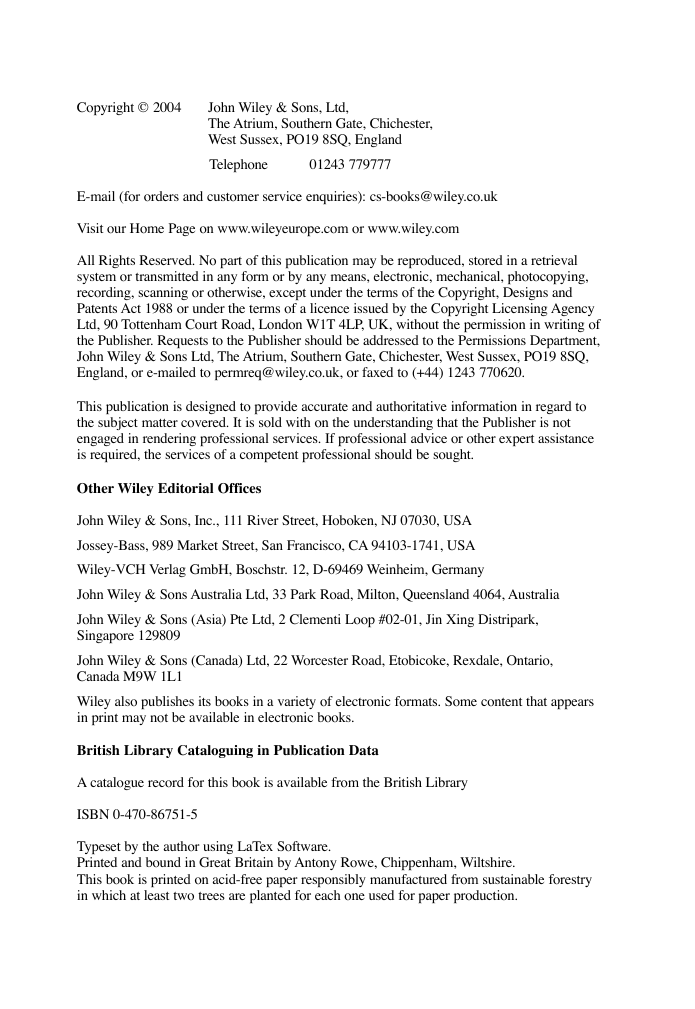Ultra Wideband Signals and Systems in Communication Engineering
Cover
Content
Preface
Acknowledgments
List of Figures
List of Tables
Introduction
I.1 Ultra wideband overview
I.2 A note on terminology
I.3 Historical development of UWB
I.4 Key benefits of UWB
I.5 UWB and Shannon's theory
I.6 Challenges for ultra wideband
I.7 Summary
1 Basic properties of UWB signals and systems
1.1 Introduction
1.2 Power spectral density
1.3 Pulse shape
1.4 Pulse trains
1.5 Spectral masks
1.6 Multipath
1.7 Penetration characteristics
1.8 Spatial and spectral capacities
1.9 Speed of data transmission
1.10 Cost
1.11 Size
1.12 Power consumption
1.13 Summary
2 Generation of ultra wideband waveforms
2.1 Introduction
2.1.1 Damped sine waves
2.2 Gaussian waveforms
2.3 Orthogonal waveforms and Hermite pulses
2.3.1 Hermite polynomials
2.3.2 Orthogonal modified Hermite pulses
2.3.3 Modulated and modified Hermite pulses
2.4 Orthogonal prolate spheroidal wave functions
2.4.1 Introduction
2.4.2 Fundamentals of PSWF
2.4.3 PSWF pulse generator
2.5 Designing waveforms for specific spectral masks
2.5.1 Introduction
2.5.2 Multi-band modulation
2.6 Practical constraints and effects of imperfections
2.7 Summary
3 Signal-processing techniques for UWB systems
3.1 The effects of lossy medium on an UWB transmitted signal
3.2 Time domain analysis
3.2.1 Classification of signals
3.2.2 Some useful functions
3.2.3 Some useful operations
3.2.4 Classification of systems
3.2.5 Impulse response
3.2.6 Distortionless transmission
3.3 Frequency domain techniques
3.3.1 Fourier transforms
3.3.2 Frequency response approaches
3.3.3 Transfer function
3.3.4 Laplace transform
3.3.5 z-Transform
3.3.6 The relationship between the Laplace transform, the Fourier transform, and the z-transform
3.4 UWB signal-processing issues and algorithms
3.5 Detection and amplification
3.6 Summary
4 Ultra wideband channel modeling
4.1 A simplified UWB multipath channel model
4.1.1 Number of resolvable multipath components
4.1.2 Multipath delay spread
4.1.3 Multipath intensity profile
4.1.4 Multipath amplitude-fading distribution
4.1.5 Multipath arrival times
4.2 Path loss model
4.2.1 Free space loss
4.2.2 Refraction
4.2.3 Reflection
4.2.4 Diffraction
4.2.5 Wave clutter
4.2.6 Aperture-medium coupling loss
4.2.7 Absorption
4.2.8 Example of free space path loss model
4.3 Two-ray UWB propagation model
4.3.1 Two-ray path loss
4.3.2 Two-ray path loss model
4.3.3 Impact of path loss frequency selectivity on UWB transmission
4.4 Frequency domain autoregressive model
4.4.1 Poles of the AR model
4.5 Summary
5 Ultra wideband communications
5.1 Introduction
5.2 UWB modulation methods
5.2.1 Pulse position modulation
5.2.2 Bi-phase modulation
5.3 Other modulation methods
5.3.1 Orthogonal pulse modulation
5.3.2 Pulse amplitude modulation
5.3.3 On-off keying
5.3.4 Summary of UWB modulation methods
5.4 Pulse trains
5.4.1 Gaussian pulse train
5.4.2 PN channel coding
5.4.3 Time-hopping PPM UWB system
5.5 UWB transmitter
5.6 UWB receiver
5.6.1 Detection
5.6.2 Pulse integration
5.6.3 Tracking
5.6.4 Rake receivers
5.7 Multiple access techniques in UWB
5.7.1 Frequency division multiple access UWB
5.7.2 Time division multiple access
5.7.3 Code division multiple access
5.7.4 Orthogonal pulse multiple access system
5.8 Capacity of UWB systems
5.9 Comparison of UWB with other wideband communication systems
5.9.1 CDMA
5.9.2 Comparison of UWB with DSSS and FHSS
5.9.3 Orthogonal frequency division multiplexing
5.10 Interference
5.10.1 Wireless local area networks
5.10.2 Bluetooth
5.10.3 GPS
5.10.4 Cellular systems
5.11 Summary
6 Ultra wideband antennas and arrays
6.1 Antenna fundamentals
6.1.1 Maxwell's equations for free space
6.1.2 Wavelength
6.1.3 Antenna duality
6.1.4 Impedance matching
6.1.5 VSWR and reflected power
6.1.6 Antenna bandwidth
6.1.7 Directivity and gain
6.1.8 Antenna field regions
6.1.9 Antenna directional pattern
6.1.10 Beamwidth
6.2 Antenna radiation for UWB signals
6.2.1 Dispersion due to near-field effects
6.3 Suitability of conventional antennas for the UWB system
6.3.1 Resonant antennas
6.3.2 Nonresonant antennas
6.3.3 Difficulties with UWB antenna design
6.4 Impulse antennas
6.4.1 Conical antenna
6.4.2 Monopole antenna
6.4.3 D-dot probe antenna
6.4.4 TEM horn antenna
6.4.5 Conclusion
6.5 Beamforming for UWB signals
6.5.1 Basic concepts
6.5.2 A simple delay-line transmitter wideband array
6.6 Radar UWB array systems
6.7 Summary
7 Position and location with ultra wideband signals
7.1 Wireless positioning and location
7.1.1 Types of wireless positioning systems
7.1.2 Wireless distance measurement
7.1.3 Microwave positioning systems
7.2 Global positioning system techniques
7.2.1 Differential GPS (DGPS)
7.2.2 GPS tracking modes
7.2.3 GPS error sources
7.3 Positioning techniques
7.3.1 Introduction
7.3.2 Network-based techniques
7.3.3 Handset-based techniques
7.3.4 Hybrid techniques
7.3.5 Other techniques
7.4 Time resolution issues
7.4.1 Narrowband systems
7.4.2 Wideband systems
7.4.3 Super-resolution techniques
7.4.4 Ultra wideband systems
7.5 UWB positioning and communications
7.5.1 Potential user scenarios
7.5.2 Potential applications
7.6 Summary
8 Applications using ultra wideband systems
8.1 Military applications
8.1.1 Precision asset location system
8.2 Commercial applications
8.2.1 Time Domain PulsON 200
8.2.2 Time Domain UWB signal generator
8.2.3 XtremeSpectrum
8.2.4 Intel corporation
8.2.5 Motorola
8.2.6 Communication Research Laboratory
8.2.7 General atomics
8.2.8 Wisair
8.2.9 Home networking and home electronics
8.2.10 Precision asset location system
8.3 Summary
References
Index
Team-kB
















 2023年江西萍乡中考道德与法治真题及答案.doc
2023年江西萍乡中考道德与法治真题及答案.doc 2012年重庆南川中考生物真题及答案.doc
2012年重庆南川中考生物真题及答案.doc 2013年江西师范大学地理学综合及文艺理论基础考研真题.doc
2013年江西师范大学地理学综合及文艺理论基础考研真题.doc 2020年四川甘孜小升初语文真题及答案I卷.doc
2020年四川甘孜小升初语文真题及答案I卷.doc 2020年注册岩土工程师专业基础考试真题及答案.doc
2020年注册岩土工程师专业基础考试真题及答案.doc 2023-2024学年福建省厦门市九年级上学期数学月考试题及答案.doc
2023-2024学年福建省厦门市九年级上学期数学月考试题及答案.doc 2021-2022学年辽宁省沈阳市大东区九年级上学期语文期末试题及答案.doc
2021-2022学年辽宁省沈阳市大东区九年级上学期语文期末试题及答案.doc 2022-2023学年北京东城区初三第一学期物理期末试卷及答案.doc
2022-2023学年北京东城区初三第一学期物理期末试卷及答案.doc 2018上半年江西教师资格初中地理学科知识与教学能力真题及答案.doc
2018上半年江西教师资格初中地理学科知识与教学能力真题及答案.doc 2012年河北国家公务员申论考试真题及答案-省级.doc
2012年河北国家公务员申论考试真题及答案-省级.doc 2020-2021学年江苏省扬州市江都区邵樊片九年级上学期数学第一次质量检测试题及答案.doc
2020-2021学年江苏省扬州市江都区邵樊片九年级上学期数学第一次质量检测试题及答案.doc 2022下半年黑龙江教师资格证中学综合素质真题及答案.doc
2022下半年黑龙江教师资格证中学综合素质真题及答案.doc